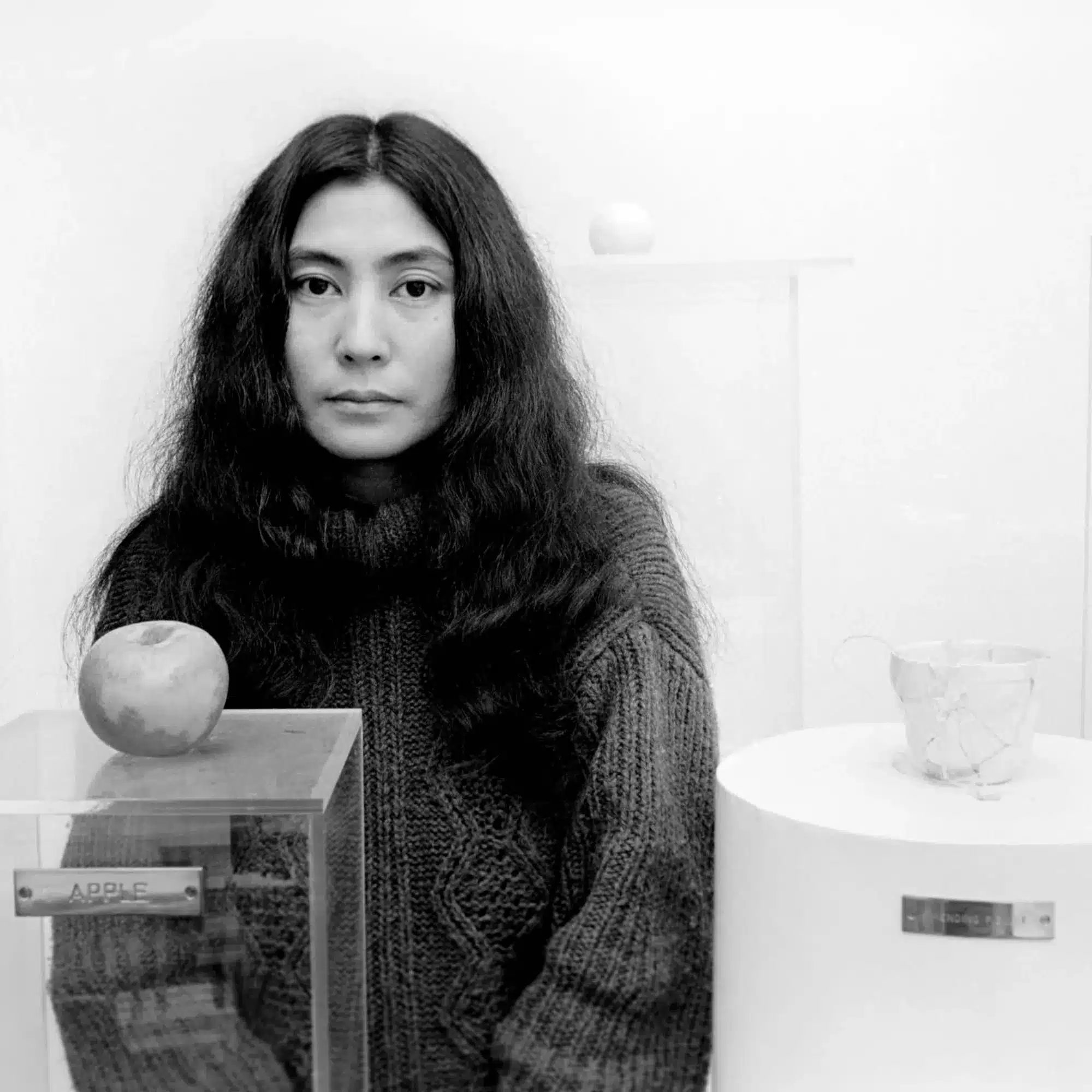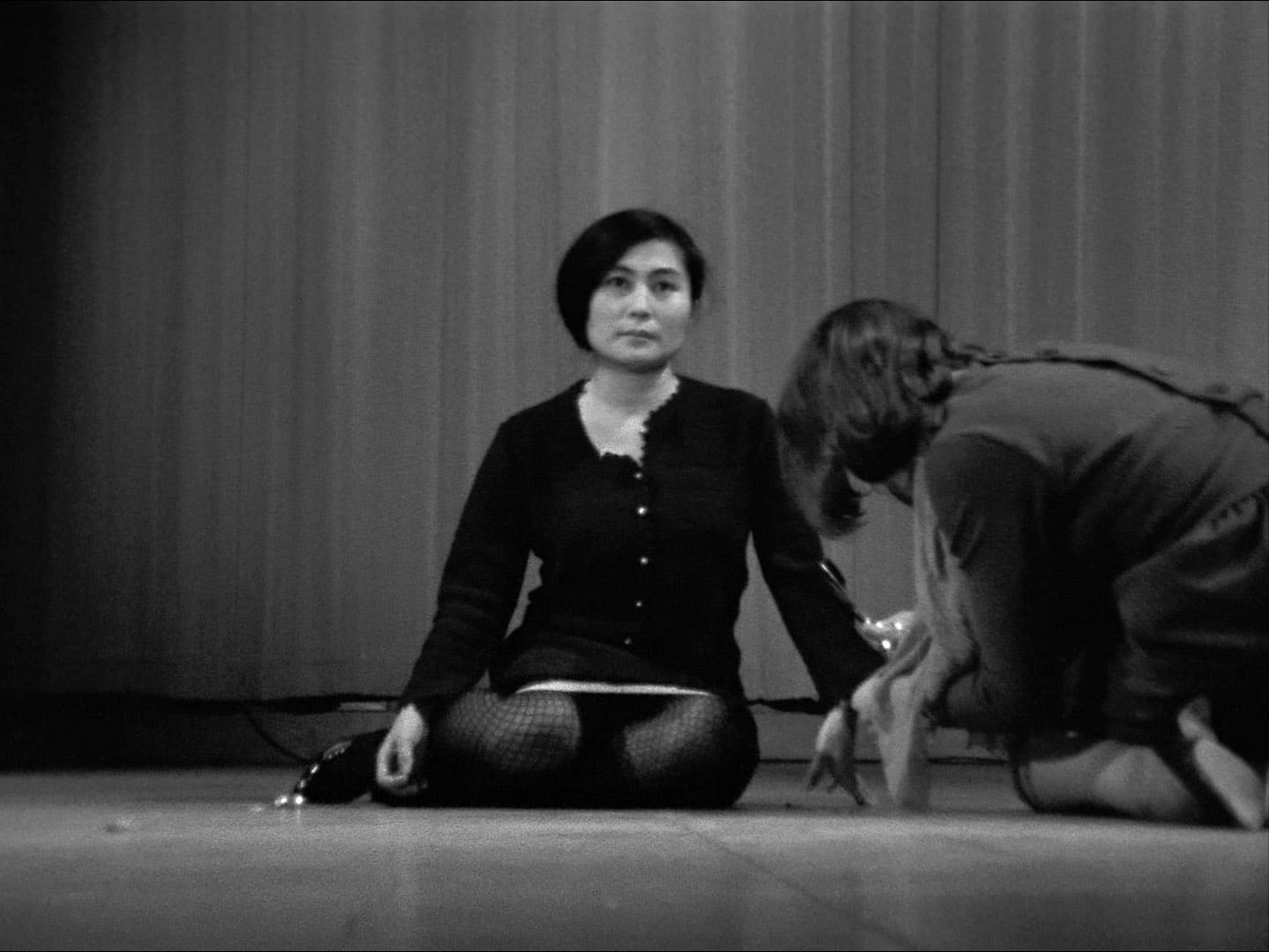Yoko Ono is a revolutionary and groundbreaking artist whose influence will be felt for years to come. Yoko Ono’s influence spans far beyond her controversial relationship with John Lennon. For decades, she has been an integral part of the art world and a driving force for change. Her works, ranging from performance art and film making to music composition and writing poetry, have inspired countless artists and activists. As we explore her most influential pieces, such as Cut Piece (1964), Grapefruit book (1964), Wish Tree (1996–present), and Refugee Boat (2019), we gain a deeper understanding and appreciation for her unique style and message. Yoko Ono continues to be a trailblazer and an inspiration to this day.
Yoko Ono’s involvement with Fluxus played an important role in revolutionizing the art world. Fluxus was a loose, international network of artists that sought to expand the boundaries of traditional forms of art. One of Ono’s most famous Fluxus works is Cut Piece (1964). In this piece, the artist sat still on a stage and invited audience members to come up and cut off pieces of her clothing until she was left in her underwear. The performance was a powerful statement about power, vulnerability, and the relationship between artist and audience.
Yoko Ono, “Cut Piece” (1964) Kyoto, Japan Performance. Learn more at MoMA Learning.1
Experience Yoko Ono’s Moving Performance of Cut Piece Live in Carnegie Hall2
Literary Works
Another one of Yoko Ono’s famous works is Grapefruit book (1964). This book contains a series of “instructional” poems that encourage the reader to engage with the world in new and unique ways. For example, one poem instructs the reader to “Imagine the sky dripping. Listen to the sound it makes” while another suggests “Smile piece: Imagine smiling at a passing stranger until the stranger smiles back.” Grapefruit book has influenced countless artists and has become a beloved work among those who seek to create art that encourages participation and engagement.
Yoko Ono Grapefruit 1964 (MOMA)3
Installations and Performance Art
Wish Tree (1996–present) is another iconic work by Yoko Ono. In this piece, Ono invites visitors to write a wish on a piece of paper and hang it on a tree. The wishes are then collected and brought to various locations around the world, where they are added to larger installations. Wish Tree has become a symbol of hope and a testament to the power of collective wishing.
Yoko Ono’s Wish Trees for London. 20124
Yoko Ono’s Refugee Boat (2019) is a poignant work that speaks to the current political climate and the ongoing struggles of refugees around the world. The installation features a small, brightly colored boat filled with personal items and snippets of stories from refugees. The boat is meant to symbolize the journey that refugees take and the resilience of the human spirit. The piece is a powerful reminder of the importance of empathy and compassion in a world that is often harsh and unforgiving.
Add Color (Refugee Boat) (1960/2019)5
Yoko Ono Radical Artist
To fully understand the impact of Yoko Ono’s art, it’s important to look beyond the individual works and examine the larger themes that permeate her creative output. Above all, Yoko Ono’s art is a celebration of humanity and a call to action for empathy, love, and peace. As she once wrote in a letter to John Lennon, “Everything will be alright. If you believe, then anything is possible.” This message continues to resonate with audiences around the world.
Yoko Ono’s Children
Yoko Ono’s influence extended beyond the art world and onto her own family, particularly her children Sean Lennon and Kyoko Cox. Ono’s marriage to her second husband, Anthony Cox, had a profound impact on both her personal and creative life.
During her marriage to Cox, Yoko Ono continued to explore performance art and experimental music. Together, they collaborated on various artistic projects that pushed the boundaries of traditional art forms. Their works often challenged societal norms and conventions, inviting audiences to question their own perceptions and expectations.
One notable performance art piece created by Yoko Ono and Anthony Cox was the “Bag Piece” in 1964. In this piece, Yoko and Cox entered a large, transparent bag together and then slowly, over the course of several minutes, emerged from it, symbolic of rebirth and transformation. The “Bag Piece” was a powerful representation of their artistic partnership and their shared desire to challenge and provoke.
Yoko Ono’s Marriage to Anthony Cox
Yoko Ono’s marriage to Anthony Cox unfortunately ended in divorce in 1969. Despite the dissolution of their relationship, the impact of their experimental art collaborations continued to resonate throughout Yoko Ono’s legacy. Their art challenged traditional notions of art and brought unconventional forms of expression to the forefront.
The experimental days of Yoko Ono, including her collaboration with Anthony Cox, left a lasting legacy on contemporary art and performance art. Their works continue to inspire and influence artists to this day, encouraging them to push boundaries, challenge societal norms, and explore new territories.
Sean Lennon and Kyoko Cox
As for Yoko Ono’s children, Sean Lennon and Kyoko Cox, they both inherited their mother’s artistic spirit and talent. Sean Lennon, as a musician and songwriter, has carved out his own successful career in the music industry, incorporating elements of his parents’ experimental and avant-garde influences. Kyoko Cox, on the other hand, has maintained a more private life and has chosen to pursue her own creative endeavors outside of the public eye.
Overall, Yoko Ono’s marriage to Anthony Cox and their collaborative performances contributed to her artistic journey and legacy. Their experimental art continues to inspire artists today, and her children have also found their own paths within the realm of art and music, honoring their mother’s influence in their own unique ways.
An indelible Mark on Culture and the Arts
Yoko Ono’s legacy as a pioneering multimedia artist, singer-songwriter, and peace activist is undeniable. Her works continue to inspire and engage audiences across the globe, and her message of love, peace, and hope is more important now than ever before. As we look back on her life’s work, we are reminded of the power of art to change the world and the importance of standing up for what we believe in. Yoko Ono’s voice may have been controversial at times, but her impact on the art world and society as a whole is undeniable.

Five Fact About Yoko Ono
- Yoko Ono was born in Tokyo, Japan, on February 18, 1933.
- She is a Japanese artist, musician, and peace activist.
- She is best known for her relationship with John Lennon, with whom she collaborated on a number of albums.
- She has also released a number of solo albums, and her work has been exhibited in museums all over the world.
- In 2009, she was named one of Time magazine’s 100 most influential people.
Film by Alex Westerman
The subject reveals diverse perspectives on how people relate to art.
A unique video art series that explores the act of looking at famous paintings and sculptures.
Footnotes
- Yoko Ono, “Cut Piece” (1964) Kyoto, Japan Performance. Learn more at MoMA Learning. ↩︎
- Performed on March 21, 1965 at Carnegie Recital Hall, New York. ↩︎
- Yoko Ono Grapefruit 1964. under the name Wunternaum Press, Tokyo (MOMA) ↩︎
- Yoko Ono’s Wish Trees for London at the “Yoko Ono To The Light” exhibition at the Serpentine Gallery, London, June 2012 ↩︎
- Add Color Painting (Refugee Boat) 1960/2016-2018 Installation view: “Catastrophe and the Power of Art,” Mori Art Museum, Tokyo, 2018 ↩︎








0 comments on “The Enduring Legacy of Yoko Ono: Exploring the Works of a Pioneering Multimedia Artist, Singer-Songwriter, and Peace Activist”